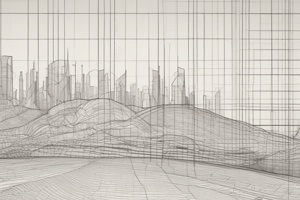Podcast
Questions and Answers
What is the marginal rate of transformation equal to?
What is the marginal rate of transformation equal to?
- The derivative of output X with respect to Y
- The ratio of the production of good X to good Y
- The derivative of output Y with respect to X (correct)
- The total output of good X and good Y
What does a point outside the production possibility frontier represent?
What does a point outside the production possibility frontier represent?
- A feasible production bundle
- A point of minimum production
- An infeasible production bundle (correct)
- A point of maximum production
If a firm moves along the production possibility frontier, what does it imply?
If a firm moves along the production possibility frontier, what does it imply?
- The firm is using the same amount of inputs to produce a different bundle of goods (correct)
- The firm is using fewer inputs
- The firm is producing the same bundle of goods
- The firm is using more inputs
What is the production possibility frontier?
What is the production possibility frontier?
At what point on the production possibility frontier are all input resources being used?
At what point on the production possibility frontier are all input resources being used?
What is the absolute value form of the marginal rate of transformation commonly noted as?
What is the absolute value form of the marginal rate of transformation commonly noted as?
What happens to the production of good Y when a firm increases its production of good X up to 100 units?
What happens to the production of good Y when a firm increases its production of good X up to 100 units?
What does an increasing marginal rate of transformation mean?
What does an increasing marginal rate of transformation mean?
What is the characteristic of the production possibility frontier with a constant marginal rate of transformation?
What is the characteristic of the production possibility frontier with a constant marginal rate of transformation?
What is the characteristic of the graph that portrays the case of perfect substitute X?
What is the characteristic of the graph that portrays the case of perfect substitute X?
What is the characteristic of the production possibility frontier with a decreasing marginal rate of transformation?
What is the characteristic of the production possibility frontier with a decreasing marginal rate of transformation?
What happens to the opportunity cost as we move down the production possibility frontier with an increasing marginal rate of transformation?
What happens to the opportunity cost as we move down the production possibility frontier with an increasing marginal rate of transformation?
What does the marginal rate of transformation indicate in the context of production?
What does the marginal rate of transformation indicate in the context of production?
What is the significance of a point on the production possibility frontier?
What is the significance of a point on the production possibility frontier?
What happens when a firm moves along the production possibility frontier?
What happens when a firm moves along the production possibility frontier?
What is the relationship between the marginal rate of transformation and the production possibility frontier?
What is the relationship between the marginal rate of transformation and the production possibility frontier?
What is implied by the shape of the production possibility frontier?
What is implied by the shape of the production possibility frontier?
What does the slope of the production possibility frontier represent?
What does the slope of the production possibility frontier represent?
What is the purpose of the production possibility frontier in economics?
What is the purpose of the production possibility frontier in economics?
What happens to the opportunity cost when a firm moves from one point to another on the production possibility frontier with a constant marginal rate of transformation?
What happens to the opportunity cost when a firm moves from one point to another on the production possibility frontier with a constant marginal rate of transformation?
How does the production possibility frontier with a decreasing marginal rate of transformation differ from the one with an increasing marginal rate of transformation?
How does the production possibility frontier with a decreasing marginal rate of transformation differ from the one with an increasing marginal rate of transformation?
What is the significance of a 45° angle with each axis in the production possibility frontier?
What is the significance of a 45° angle with each axis in the production possibility frontier?
What is the implication of a firm's production being on the production possibility frontier?
What is the implication of a firm's production being on the production possibility frontier?
How does the production possibility frontier relate to the concept of opportunity cost?
How does the production possibility frontier relate to the concept of opportunity cost?
Flashcards are hidden until you start studying
Study Notes
Marginal Rate of Transformation (MRT)
- The marginal rate of transformation (MRT) is the number of units of good X that must be stopped producing to produce an extra unit of good Y, while keeping production factors and technology constant.
- MRT can be determined using the formula: absolute value of the derivative of output Y with respect to X.
- It represents how much the production of output Y will increase or decrease with every additional unit of output X.
Production Possibility Frontier (PPF)
- The production possibility frontier (PPF) represents the various combinations of two goods that a firm can produce.
- The horizontal axis represents the production level of good X, and the vertical axis represents the production of good Y.
- Points on or inside the PPF are feasible production bundles, while points outside are not feasible.
- The slope of the PPF shows how reallocation of production can result in a different bundle of goods while employing the same quantity of inputs.
Shapes of Production Possibility Frontier
- Increasing MRT and Opportunity Cost: as you move down the slope, more units of good Y have to be given up to increase the production of good X.
- Constant MRT and Opportunity Cost: the same units of one good have to be given up to produce more units of the other good.
- Decreasing MRT and Opportunity Cost: the cost in terms of the given up good decreases with every unit given up to produce another unit of the other good.
- Perfect Substitute: the slope has an angle of 45° with each axis, and the MRT is equal to 1.
Firm's Production Decisions
- A firm can move along the PPF to produce a different bundle of goods while using the same amount of total inputs.
- The firm may increase its production of good X while reducing its production of good Y, or vice versa.
Studying That Suits You
Use AI to generate personalized quizzes and flashcards to suit your learning preferences.




